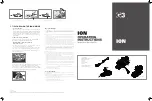
1—2
Page 3
AP101B-7200-15
Fuel System
Fuel Loading
6. Over wing refuelling points are provided for each tank with integral
bonding points. Fuel is to be loaded in accordance with the RTS and
the SOIU. Fuel loads are always kept to a practical minimum in order to
reduce fatigue. A 5% increase in AUW gives a 15% increase in fatigue.
In order to maximise wing relief in flight, and reduce wing flexing on
landing, the No. 3 tanks should always be full for take-off and empty for
landing.
7. Fuel is loaded as follows:
a. 100 gallons are loaded into each of the No. 3 tanks.
b. The remainder of the required fuel load is divided equally between
the No. 1 and No. 2 tanks.
8. An example fuel load of 800 gallons is distributed as follows:
No. 1 Tank
2 x 150 gallons
300 gallons
No. 2 Tank
2 x 150 gallons
300 gallons
No. 3 Tank
2 x 100 gallons
200 gallons
Total Fuel Load
800 gallons
CAUTION:
Although the total fuel capacity is 2154 gallons, dependent
on the ZFW:
a. If more than 800 gallons are loaded, the normal maximum all up
weight of 48,000 lb is likely to be exceeded.
b. If more than 1100 gallons are loaded, the never exceed maximum
all up weight is likely to be exceeded.
Fuel Pumps
9. Fuel pumps maintain fuel pressure at altitudes above 17,000ft and
can be used to prime the fuel lines prior to starting. Each tank has a
pulsometer fuel pump, which produces a nominal 23PSI. No. 1 and 2
tanks pumps have a suction bypass that allows the fuel to pass from the
tank under gravity in the case of booster pump failure or prolonged cruise
UNCONTROLLED DOCUMENT - NOT FOR USE IN FLIGHT OR TO BE PRINTED
UNCONTROLLED DOCUMENT - NOT FOR USE IN FLIGHT OR TO BE PRINTED
















































